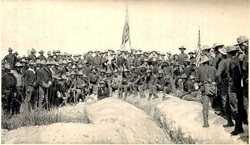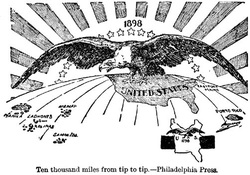The Result

"Yellow Journalism" and propaganda during the 1890's led to the Spanish-American War. On April 11, 1898, McKinley asked congress to use force against the Spanish to end the fighting in Cuba. When he asked congress for war, he stated,
"In the name of humanity, in the name of civilization, in behalf of endangered American interests."
The War Begins
Congress then enacted four resolutions that amounted to a declaration of war on Spain. The fourth resolution, the Teller Amendment, specified that America had no intentions of annexing Cuba. The first major battle of the Spanish-American war was the Battle of Manila Bay. The U.S Navy's Asiatic Squadron under Commodore Dewey's command defeated the Spanish Pacific Fleet in an overwhelming victory with no casualties on the side of the U.S. The most famous unit in the war was organized and commanded by Theodore Roosevelt. His unit was called the Rough Riders and consisted of rugged westerners and upper-class easterners. The Rough Riders was a cavalry unit and gained fame for the role they played in the battles of Kettle and San Juan hills.
The Fall of Spanish Control
In December 1898, the Treaty of Paris signed by Spain and the United States officially ended the war. Spain gave up control of Cuba, Puerto Rico, and Guam. Spain also sold the Philippines to the United States for $20 million. The Spanish American War was important because it unified Americans in a common cause, promoted internationalism, and allowed America to become a competitive world power.
"In the name of humanity, in the name of civilization, in behalf of endangered American interests."
The War Begins
Congress then enacted four resolutions that amounted to a declaration of war on Spain. The fourth resolution, the Teller Amendment, specified that America had no intentions of annexing Cuba. The first major battle of the Spanish-American war was the Battle of Manila Bay. The U.S Navy's Asiatic Squadron under Commodore Dewey's command defeated the Spanish Pacific Fleet in an overwhelming victory with no casualties on the side of the U.S. The most famous unit in the war was organized and commanded by Theodore Roosevelt. His unit was called the Rough Riders and consisted of rugged westerners and upper-class easterners. The Rough Riders was a cavalry unit and gained fame for the role they played in the battles of Kettle and San Juan hills.
The Fall of Spanish Control
In December 1898, the Treaty of Paris signed by Spain and the United States officially ended the war. Spain gave up control of Cuba, Puerto Rico, and Guam. Spain also sold the Philippines to the United States for $20 million. The Spanish American War was important because it unified Americans in a common cause, promoted internationalism, and allowed America to become a competitive world power.


